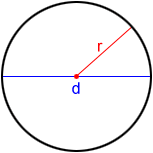Pi
Pi (π) is the ratio of the circumference of a circle to its diameter. The value of pi is 3.14159..., an irrational number.
Pi is a constant value. That is, the ratio of the circumference to the diameter is the same for all circles. The drawing below shows the circumference of a circle that has been "straightened out." It is a little more than three diameters in length:

The number pi
Pi is an irrational number. An irrational number does not have a repeating pattern and does not end, so it can only be approximated. Calculated to one hundred places after the decimal:
π ≈ 3.1415926535897932384626433832795028841971693993751058209749445923078164062862089986280348253421170679
3.14 and (or
) are often used as approximate values for pi.
Equations using pi
Pi is used widely in equations in geometry, trigonometry, and other branches of mathematics:
Circumference of a circle
Pi is the ratio of the circumference of a circle to its diameter:
Using this relationship, we can determine equation for the circumference of a circle by solving for C:
C = πd or C = 2πr
where C is the circumference, d is the diameter, and r is the radius of the circle.

Area of a circle
Another well-known formula that uses pi is the area of a circle. The area of a circle is the region that is bounded by the circumference of a circle.
A = πr2
where A is the area and r is the radius of the circle.

Sphere
For a sphere that has a radius of r,

Right circular cylinder
For a right circular cylinder that has a radius of r and height h,
Volume = πr2h
Lateral surface area = 2πrh

Right circular cone
A right circular cone that has a radius of r and height h,

